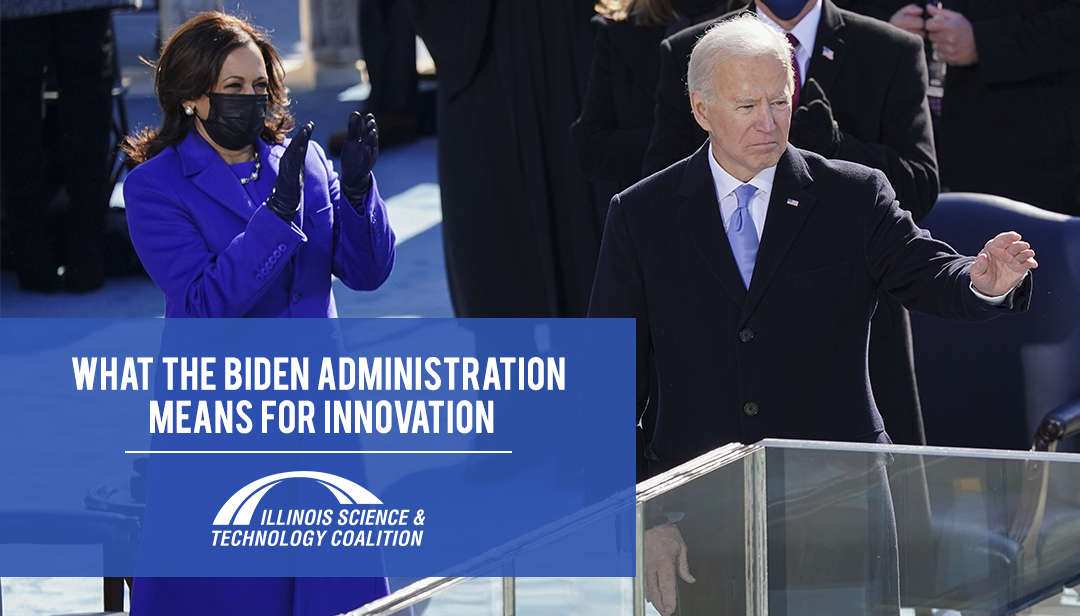By Matthew Bragg, Director, ISTC
With the Biden administration now in the White House, and a typically short window for substantive policy change, several innovation-related proposals seem likely to be considered in the months to come. In this Catalyst, we focus on three priority areas for the new President; COVID relief, immigration reform, and infrastructure—assessing the potential impact of each on Illinois’ innovation economy.
COVID Relief
Most pressing on the agenda is a new COVID-19 economic relief and stimulus proposal. Last week, the incoming Biden administration unveiled its $1.9 trillion “American Rescue Plan.” The plan is headlined by additional $1,400 per-person checks, bringing recent stimulus payments for individuals up to the $2,000 level championed (uniquely) by congressional progressives and President Trump late last year. The proposal also includes $350 billion in emergency funding for state and local governments, as well as funding for vaccination rollout, expanded childcare and SNAP benefits, and to help reopen schools.
Relevant to innovation, Biden’s proposed package also includes a $35 billion investment in successful state, local, tribal, and non-profit small business financing programs—helping them leverage “as much as $175 billion in low-interest loans and venture capital to help entrepreneurs — including those in the clean energy sector — innovate, create and maintain jobs, build wealth, and provide the essential goods and services that communities depend on.”
“…Biden’s proposed package also includes a $35 billion investment in successful state, local, tribal, and non-profit small business financing programs…”
The language provided by the Biden administration is similar to that of the Obama-era U.S. Department of the Treasury’s State Small Business Credit Initiative (SSBCI)—which was created in 2010 before expiring in 2017. The SSBCI program provided $78.7 million to the Illinois Department of Commerce and Economic Opportunity (DCEO), which used the funding to operate four credit support programs and a venture capital program collectively known as Advantage Illinois (a detailed overview of Illinois’ SSBCI funded programs can be found here).
The SSBCI program gave state recipients wide discretion when making funding available to small businesses. Given the similar language and ties to the Obama administration, it’s likely that similar flexibility would exist under the current $35 billion proposal—although it’s yet to be seen how this administration’s focus on clean energy could come into play. For Illinois, this proposal presents an opportunity to inject needed capital into small, high-tech businesses that can help grow the state’s economy.
For more on Biden’s COVID plan and innovation, read SSTI’s analysis here.
Immigration Reform
On the administration’s first full day in office, it proposed an immigration bill that provides a pathway to citizenship for undocumented immigrants and immidiate green card eligibility for DACA recipients. Biden also signaled intent to preserve and fortify DACA through a memorandum to the Secretary of Homeland Security. A separate executive order also repealed the controversial “Muslim ban.” These actions were largely applauded by immigrant support organizations, as well as college and universities, which have argued that the previous administration’s hardline stance on immigration—as well as visa processing delays—made attracting and retaining international students difficult.
Relevant to innovation, Biden’s proposed immigration reform bill “…makes it easier for graduates of U.S. universities with advanced STEM degrees to stay in the United States,” according to a fact sheet released by the administration. The bill would also reform elements of the H-1B visa system, including providing work permits to dependents of H-1B visa holders, including college students, and preventing them from aging out of the system. The bill would also increase or remove per-country visa caps.
“Biden’s proposed immigration reform bill ‘…makes it easier for graduates of U.S. universities with advanced STEM degrees to stay in the United States.’”
Though the full text of the bill has not yet been released, the priorities outlined by the administration are undoubtedly positive for Illinois’ innovation community. ISTC has long advocated for immigration policies that allow our colleges and universities to attract the brightest talent from around the world, as well as programs like OPT and H-1B visas that allow the state to retain this talent to benefit our innovation economy.
Infrastructure
Perhaps President Biden’s most ambitious proposal is his desired $2 trillion infrastructure plan. Due out in February, Biden has framed the plan as long-term economic recovery that will “make historic investments in infrastructure, along with manufacturing, research and development and clean energy.” Biden has said he would like to spend $50 billion on road and bridge repairs in just his first year in office, as well as focusing on transit in high-poverty areas, and on high speed rail. Plans among congressional Democrats also focus on items like advancing clean energy innovation, including battery storage and electric vehicles—in line with the new administration’s stated focus on green jobs.
“Biden has framed the plan as long-term economic recovery that will ‘make historic investments in infrastructure, along with manufacturing, research and development and clean energy.”
The looming $2 trillion question is how to pay for these infrastructure investments. With the Senate split down the middle, creating revenue through traditional means like raising the federal gasoline tax (which has held steady since 1993) will likely be difficult. Simply raising the deficit to cover the cost will also be politically challenging.
If the new administration is able to pass a large infrastructure bill, it stands to significantly benefit innovation in Illinois, thanks to Biden’s focus on “…manufacturing, research and development and clean energy.” On the manufacturing front, Illinois is home to MxD, a national manufacturing innovation hub—as well as IMEC, part of NIST’s Manufacturing Extension Partnership (MEP) network supporting small and medium-sized manufacturers across the state. Illinois is also a national leader in clean energy research and development, with both in-state federal labs, Argonne and Fermilab, conducting advanced research in the area.
Are there innovation policy items we’ve missed, or opportunities to support your organization’s policy priorities? Get in touch.

